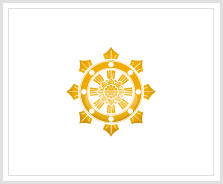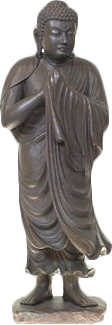Difference between revisions of "Buddhist Association of Shinnyo-En"
(Created page with "{{AU Buddhist Organizations Input |Native Name=Shinnyo-en (buddhahood) |image=Shinnyo en.jpg |imagecaption=Shinnyo-en Logo |traditionlinage=Japanese Esoteric Buddhism |mainbud...") |
|||
| Line 6: | Line 6: | ||
|mainbuddhistschool=Mahayana | |mainbuddhistschool=Mahayana | ||
|subschool=Japanese | |subschool=Japanese | ||
| + | |founded=1936 | ||
|founder=Master Shinjo Ito | |founder=Master Shinjo Ito | ||
|house/unit nr=231 | |house/unit nr=231 | ||
| Line 17: | Line 18: | ||
|email=shinnyoenaustralia@gmail.com | |email=shinnyoenaustralia@gmail.com | ||
}} | }} | ||
| − | == | + | == Welcome == |
| + | [[File:GrayBuddha.jpg|thumb|250px|left|Buddha]] | ||
| + | Shinnyo-en Australia is a lay Buddhist community serving the needs of Shinnyo-en members and their communities throughout Australia and New Zealand. Shinnyo-en is a worldwide community that offers people a pathway to finding true joy in this life that is applicable to a modern lifestyle yet with a strong foundation of traditional Buddha. | ||
| − | [[Shinnyo-en | + | == What is Shinnyo-en? == |
| + | [[File:Buddhism For Our Times.jpg|thumb|250px|left|]] | ||
| + | Shinnyo-en is a Buddhist community that is based on the "last teachings" of Gautama Buddha, the founder of Buddhism. Its aim is to make the enlightenment of the Buddha available to as many people as possible through the vehicle of self-reflection and altruism. Through the centuries, Buddhist training leading to enlightenment has been available to all, but it has been mostly those who renounced the worldly life to become monks or nuns who have taken advantage of it. | ||
| + | Shinnyo-en provides an alternative framework for guidance and practice so that ordinary people can make society their primary training ground. Its doctrine is firmly grounded in traditional Buddhism, and lay practitioners can train to achieve a state of mind on par with conventional clergy. In short, it is a diverse spiritual community (sangha) that tries to support each and every one of its members to walk the path toward wisdom and enlightenment. | ||
| − | + | == History == | |
| + | [[File:Shinjo.jpg|thumb|250px|left|The Master]] | ||
| + | Shinnyo-en was founded in 1936 by Master Shinjo Ito and his wife Tomoji. Shinjo trained at Daigoji, the head temple of the Daigo School of Shingon esoteric Buddhism. There, he mastered all the trainings and gained the title of Great Acharya ("Great Master"). He became a successor of the "dharma stream," the traditional flow of Buddhist wisdom handed down in an unbroken line since the time of the Buddha over two thousand five hundred years ago. This also qualified him to start his own lineage, or denomination. However, because Shingon Buddhism is an esoteric tradition, it forbids revealing its teachings to the non-initiated. | ||
| − | + | Esoteric refers to an understanding that cannot be described or taught through human language, as doing so would prevent full understanding. Esoteric Buddhism (or Vajrayana) developed relatively late in Buddhist history, and so it includes all the teachings that came before it. Emphasizing direct experience of practice rather than religious discipline, study of texts, or other external methods, it also requires that teachings and rites be passed on only by a senior in faith who is sure that the trainee is indeed ready to receive them. | |
| − | + | Searching for a way to share the enlightenment he had realized through Shingon, Shinjo further studied the Buddhist teachings and came across a set of scriptures known as the Nirvana or Mahaparinirvana ("Great Passing into Nirvana") Sutra, the "last teachings" of the Buddha. Reading this sutra, Shinjo realized that its all-embracing concepts were the doctrinal support he needed to make effective spiritual practice accessible to everyone. | |
| + | Today, the Shinnyo-en path to spiritual liberation is recognized in official and Buddhist circles as an independent branch of esoteric Buddhism (Jpn. Mikkyo). Since the passing in 1989 of Shinjo Ito, the order has been led by his successor, Her Holiness Shinso Ito. | ||
| − | === | + | == Basic Doctrine == |
| + | [[File:Basic Doctrine.png|thumb|250px|left|]] | ||
| + | The Founder's training in esoteric Buddhism emphasized becoming aware of the ever-present lovingkindness, compassion, and wisdom that fill the universe and inspire people at the deepest level. In Buddhism, one way of referring to such consciousness is "buddha nature" (the potential for buddhahood), but traditionally, most who focused on cultivating this part of themselves became monks and nuns. The Nirvana Sutra encourages all people–monastic and lay practitioner alike–to help themselves by helping others, as everyone has a buddha nature at their core, whether they are aware of it or not. | ||
| − | + | In summary, the Sutra's four major principles are: | |
| − | + | # Everyone has a buddha nature, without exception. | |
| − | + | # "Buddha" is always present and transcends the historical figure (Gautama). | |
| + | # Even the worst wrongdoer (defined as someone who willfully tries to destroy people's faith) can eventually attain buddhahood. | ||
| + | # Nirvana is state of mind we cultivate in the here and now. It is always available, joyful, a revelation of the true self, and pure. | ||
| − | + | In essence, the Nirvana Sutra contains a hopeful message: that all people, by acting altruistically and reaching into themselves through reflection and meditation, can bring forth the great joy, lovingkindness, and compassion of buddhas. The Founder sculpted a statue of the Buddha giving his last teachings (a Parinirvana Buddha) as a symbol of the inherent buddha nature in all beings and the self-realization preached in the Nirvana Sutra. | |
| − | |||
| − | |||
| − | |||
| − | |||
| − | |||
| − | |||
| − | |||
| − | == | + | == Lineage System == |
| + | [[File:Lineage System.jpg|thumb|250px|left|Lineage System]] | ||
| + | Everyone at Shinnyo-en becomes a member through a mentor called "guiding parent." This is the person who introduces a new follower to the community and helps that person to practice. | ||
| − | + | When the community was small, Shinjo and Tomoji Ito guided followers directly, making them feel like part of a family. However, with increasing numbers of followers, such direct guidance became impossible, and so guiding parents are now responsible for conveying their same loving kindness and compassion. This dharma (teaching) relationship helps both the "guiding parent" and the "guiding child" to exchange experiences, gain greater insight, and practice in a way that nurtures each other's Buddha nature. | |
| − | + | Through this system of guiding parents and guiding children, members are organized into groups called "lineages" that cater to people's individual needs and for maintaining the warm feeling of fellowship that has existed since Shinnyo-en's birth. | |
| − | |||
| − | |||
| − | |||
| − | |||
| − | |||
| − | |||
| − | |||
| − | |||
| − | |||
| − | |||
| − | |||
| − | |||
| − | |||
| − | |||
| − | |||
| − | |||
| − | |||
| − | |||
| − | |||
| − | |||
| − | |||
| − | |||
| − | |||
| − | |||
| − | |||
| − | |||
| − | |||
| − | |||
| − | |||
| − | |||
| − | |||
| − | |||
| − | |||
| − | |||
| − | |||
| − | |||
| − | |||
| − | |||
| − | |||
| − | |||
| − | |||
| − | |||
| − | |||
| − | |||
| − | |||
| − | |||
| − | |||
| − | |||
| − | |||
| − | |||
| − | |||
| − | |||
| − | |||
| − | |||
| − | |||
| − | |||
| − | |||
| − | |||
| − | |||
| − | |||
| − | |||
| − | |||
| − | |||
| − | |||
| − | |||
| − | |||
| − | |||
| − | |||
| − | |||
| − | |||
| − | |||
| − | |||
| − | |||
| − | |||
| − | |||
{{R}} | {{R}} | ||
| − | + | https://www.shinnyo.org.au/ | |
| − | |||
Revision as of 01:36, 5 November 2015
| Buddhist Association of Shinnyo-En | |
|---|---|
Shinnyo-en Logo | |
| Information | |
| Tradition/Linage | Japanese Esoteric Buddhism |
| Main School | Mahayana |
| Sub School | Japanese |
| Founded | Founded(when)::1936 |
| People | |
| Founder(s) | BUORG-Names::Names::Master Shinjo Ito |
| Contact Infotmation | |
| Address | 231 Longueville Road Lane Cove New South Wales 2066 Australia |
| Country | Australia |
| Coordinates | service=google }} {{#geocode:231Longueville RoadLane CoveNew South WalesAustralia|format=float|service=google}} service=google }}The "_geo" type of this property is invalid |
| Map | {{#display_map:{{#geocode:231Longueville RoadLane CoveNew South WalesAustralia}}|height=250px|width=250px|zoom=18}} |
| Phone | Phone::(02) 9418 6688 |
| Website | Website::https://www.shinnyo.org.au/ "Website" has not been listed as valid URI scheme. |
| Email::shinnyoenaustralia@gmail.comURIs of the form "Email::shinnyoenaustralia@gmail.com" are not allowed. | |
Welcome
Shinnyo-en Australia is a lay Buddhist community serving the needs of Shinnyo-en members and their communities throughout Australia and New Zealand. Shinnyo-en is a worldwide community that offers people a pathway to finding true joy in this life that is applicable to a modern lifestyle yet with a strong foundation of traditional Buddha.
What is Shinnyo-en?
Shinnyo-en is a Buddhist community that is based on the "last teachings" of Gautama Buddha, the founder of Buddhism. Its aim is to make the enlightenment of the Buddha available to as many people as possible through the vehicle of self-reflection and altruism. Through the centuries, Buddhist training leading to enlightenment has been available to all, but it has been mostly those who renounced the worldly life to become monks or nuns who have taken advantage of it. Shinnyo-en provides an alternative framework for guidance and practice so that ordinary people can make society their primary training ground. Its doctrine is firmly grounded in traditional Buddhism, and lay practitioners can train to achieve a state of mind on par with conventional clergy. In short, it is a diverse spiritual community (sangha) that tries to support each and every one of its members to walk the path toward wisdom and enlightenment.
History
Shinnyo-en was founded in 1936 by Master Shinjo Ito and his wife Tomoji. Shinjo trained at Daigoji, the head temple of the Daigo School of Shingon esoteric Buddhism. There, he mastered all the trainings and gained the title of Great Acharya ("Great Master"). He became a successor of the "dharma stream," the traditional flow of Buddhist wisdom handed down in an unbroken line since the time of the Buddha over two thousand five hundred years ago. This also qualified him to start his own lineage, or denomination. However, because Shingon Buddhism is an esoteric tradition, it forbids revealing its teachings to the non-initiated.
Esoteric refers to an understanding that cannot be described or taught through human language, as doing so would prevent full understanding. Esoteric Buddhism (or Vajrayana) developed relatively late in Buddhist history, and so it includes all the teachings that came before it. Emphasizing direct experience of practice rather than religious discipline, study of texts, or other external methods, it also requires that teachings and rites be passed on only by a senior in faith who is sure that the trainee is indeed ready to receive them.
Searching for a way to share the enlightenment he had realized through Shingon, Shinjo further studied the Buddhist teachings and came across a set of scriptures known as the Nirvana or Mahaparinirvana ("Great Passing into Nirvana") Sutra, the "last teachings" of the Buddha. Reading this sutra, Shinjo realized that its all-embracing concepts were the doctrinal support he needed to make effective spiritual practice accessible to everyone. Today, the Shinnyo-en path to spiritual liberation is recognized in official and Buddhist circles as an independent branch of esoteric Buddhism (Jpn. Mikkyo). Since the passing in 1989 of Shinjo Ito, the order has been led by his successor, Her Holiness Shinso Ito.
Basic Doctrine
The Founder's training in esoteric Buddhism emphasized becoming aware of the ever-present lovingkindness, compassion, and wisdom that fill the universe and inspire people at the deepest level. In Buddhism, one way of referring to such consciousness is "buddha nature" (the potential for buddhahood), but traditionally, most who focused on cultivating this part of themselves became monks and nuns. The Nirvana Sutra encourages all people–monastic and lay practitioner alike–to help themselves by helping others, as everyone has a buddha nature at their core, whether they are aware of it or not.
In summary, the Sutra's four major principles are:
- Everyone has a buddha nature, without exception.
- "Buddha" is always present and transcends the historical figure (Gautama).
- Even the worst wrongdoer (defined as someone who willfully tries to destroy people's faith) can eventually attain buddhahood.
- Nirvana is state of mind we cultivate in the here and now. It is always available, joyful, a revelation of the true self, and pure.
In essence, the Nirvana Sutra contains a hopeful message: that all people, by acting altruistically and reaching into themselves through reflection and meditation, can bring forth the great joy, lovingkindness, and compassion of buddhas. The Founder sculpted a statue of the Buddha giving his last teachings (a Parinirvana Buddha) as a symbol of the inherent buddha nature in all beings and the self-realization preached in the Nirvana Sutra.
Lineage System
Everyone at Shinnyo-en becomes a member through a mentor called "guiding parent." This is the person who introduces a new follower to the community and helps that person to practice.
When the community was small, Shinjo and Tomoji Ito guided followers directly, making them feel like part of a family. However, with increasing numbers of followers, such direct guidance became impossible, and so guiding parents are now responsible for conveying their same loving kindness and compassion. This dharma (teaching) relationship helps both the "guiding parent" and the "guiding child" to exchange experiences, gain greater insight, and practice in a way that nurtures each other's Buddha nature.
Through this system of guiding parents and guiding children, members are organized into groups called "lineages" that cater to people's individual needs and for maintaining the warm feeling of fellowship that has existed since Shinnyo-en's birth.





